Heterodontosauridae
|
The Heterodonosauridae are a small clade branching off near the base of the ornithischian tree. One of their key characteristics, for which they are named, is the presence of two distinct types of teeth, an anterior set of long "canines" and uniquely shaped cheek teeth. Heterodontosaurids are all small, bipedal herbivores with large eyes.
This is the skull of Heterodontosaurus tucki
Taxonomy: Ornithischia, Heterodontosauridae
Southern Africa
Early Jurassic Period, 200 Ma
Dinosaur Discovery Site, Utah
|
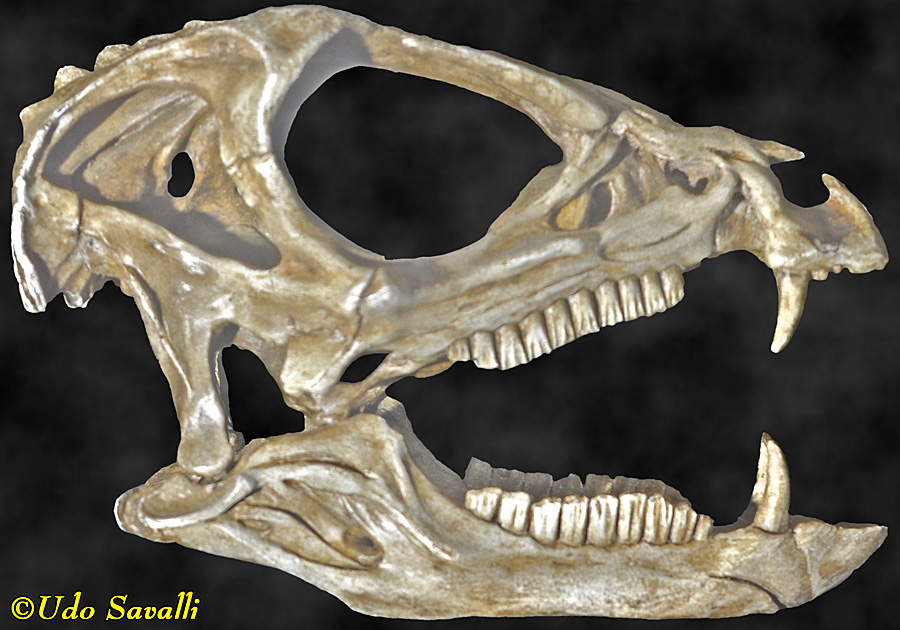
|
|
|
Life model of Fruitadens haagarorum.
Taxonomy: Dinosauria; Ornithischia; Heterodontosauridae
Late Jurassic Period; North America
Los Angeles Museum of Natural History
|
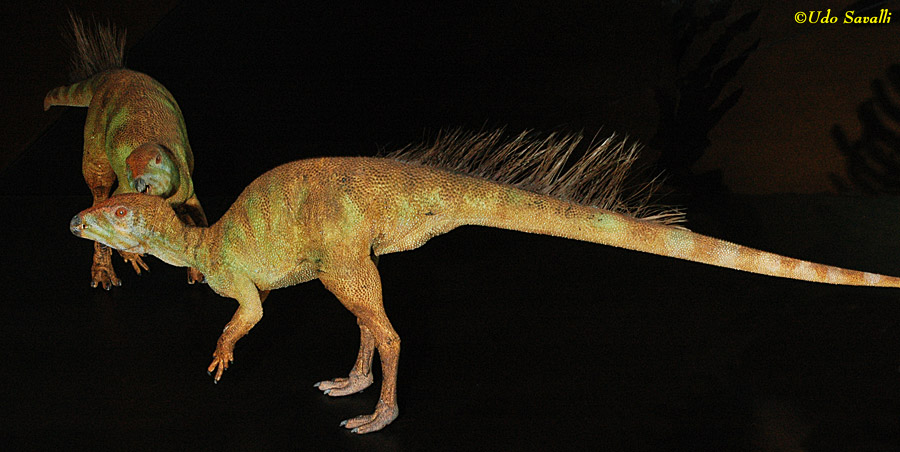
|
|
Basal Thyreophora — Armored Dinosaurs
|
The Thyreophora are the armored dinosaurs characterized by having multiple (2 or more) rows of dorsal osteoderms (dermal bone in the skin). The extent, arrangement, and shapes of the osteoderms, which can also form extended plates and spikes, varies considerably. Like all(?) ornithischians, thyreophorans were herbivorous (at least as adults).
Scelidosaurus harrisonii (fossil cast) may be a basal thyreophoran (meaning it branched off before the split between the ankylosaurs and stegosaurs or it may be the most primitive member of the ankylosaurs. Its armor was less well developed than either of those groups and it may have been capable of some bipedal locomotion.
Taxonomy: Ornithischia, Thyreophora, Scelidosauridae
England
Early Jurassic Period, 194 Ma
Dinosaur Discovery Site, Utah
|
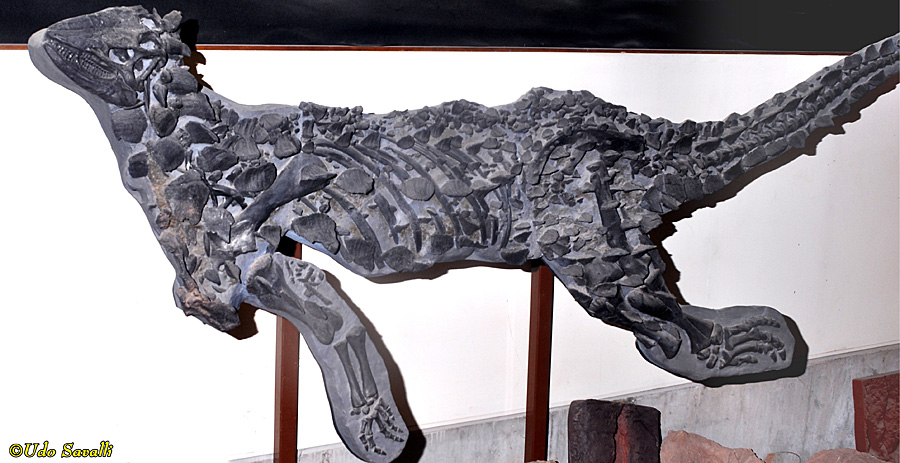
|
|
|
Life model of Scutellosaurus sp., a basal thyreophoran.
Taxonomy: Dinosauria; Ornithischia; Thyreophora
Early Jurassic Period
Arizona Museum of Natural History
|
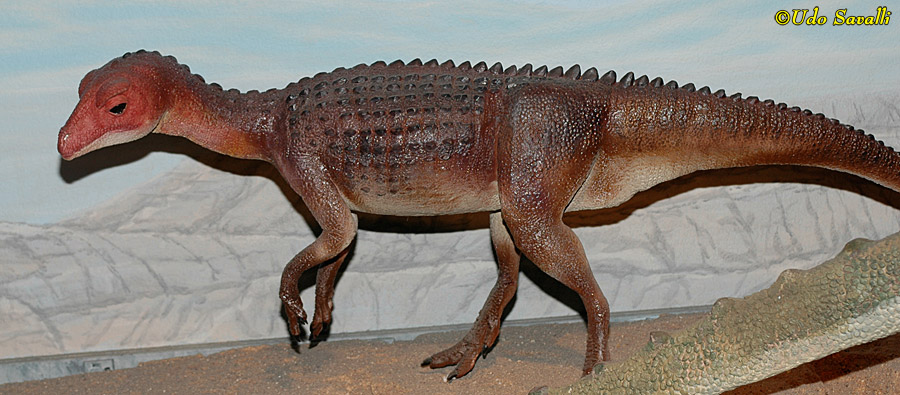
|
|
Ankylosauria
|
The Ankylosauria are low, broad-bodied and very heavily armored with dorsal osteoderms forming a near complete carapace (the large osteoderms, as seen here, are often surrounded by many very small osteoderms). They would have been difficult for a predator to attack or to flip over. The ankylosaurs are subdivided into two families, the Ankylosauridae and the Nodosauridae.
Gastonia burgei is an example of a nodosaurid, which generally have more spiky armor and a longer, narrower head than the ankylosaurids, and never have a tail club.
Taxonomy: Ornithischia, Thyreophora, Ankylosauria, Nodosauridae
North America
Early Cretaceous Period, 126 Ma
Museum of Ancient Life, Utah
|
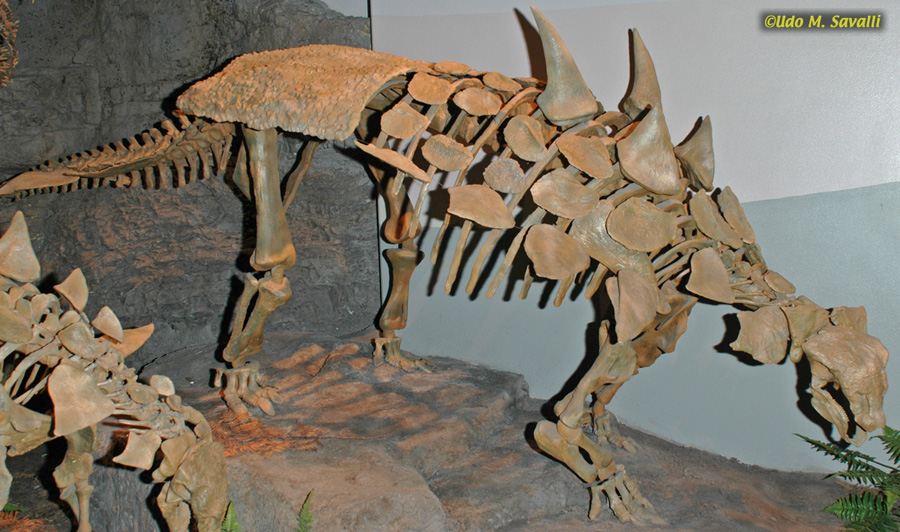
|
|
|
In some nodosaurs, such as this Gargoyleosaurus parkpinorum, the osteoderms over the hips were fused into a single large plate.
Taxonomy: Ornithischia, Thyreophora, Ankylosauria, Nodosauridae
North America
Late Jurassic Period, Kimmeridgian-Tithonian Stages, 150 Ma
Museum of Ancient Life, Utah
|
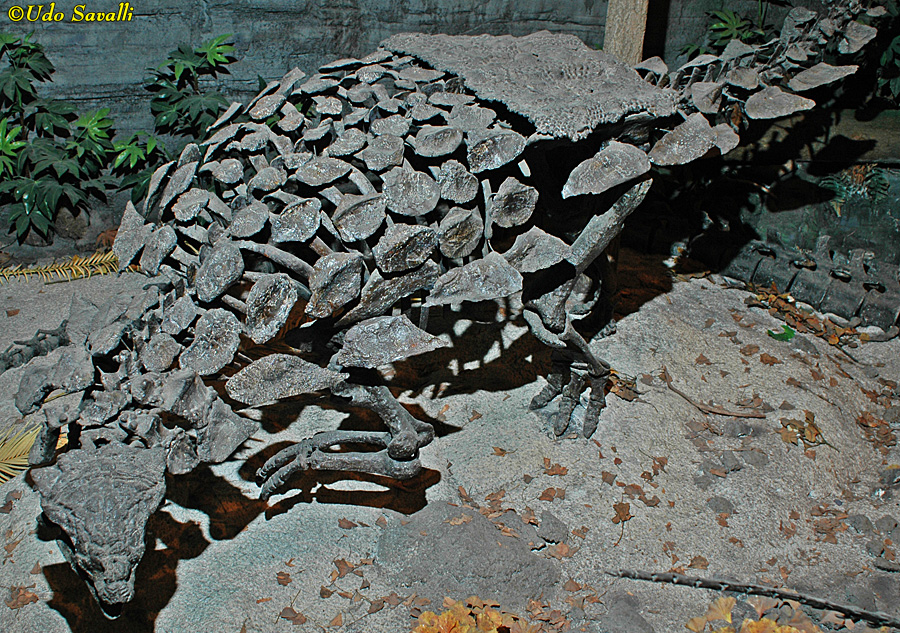
|
|
|
The nodosaurid Mymoorapelta maysi.
Taxonomy: Ornithischia, Thyreophora, Ankylosauria, Nodosauridae
Morrison Formation, western USA
Late Jurassic Period, 156-148 Ma
Wyoming Dinosaur Center
|
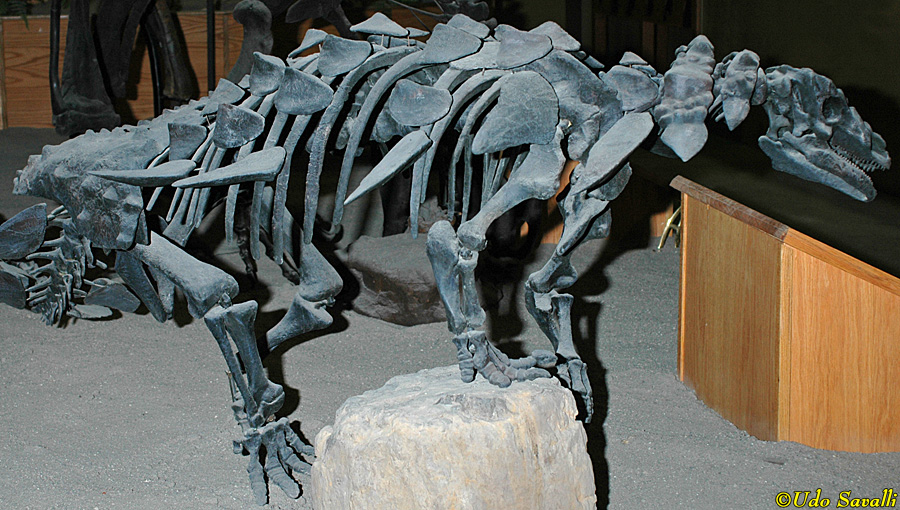
|
|
|
This Denversaurus schlessmani skull illustrates the longer, narrower skull of the nodosaurids compared to the ankylosaurids (below).
Taxonomy: Ornithischia, Thyreophora, Ankylosauria, Nodosauridae
Hell Creek Formation, Montana
Late Cretaceous Period, Maastrichtian Stage
Black Hills Institute Museum, South Dakota
|
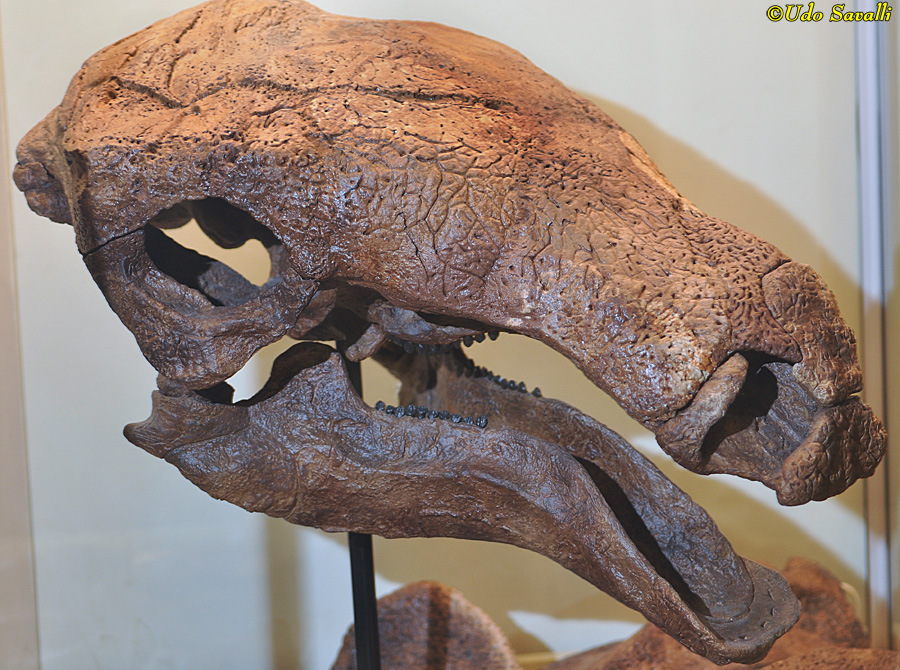
|
|
|
Life model of Mymoorapelta maysi.
Taxonomy: Dinosauria; Ornithischia; Thyreophora; Ankylosauria; Nodosauridae
Late Jurassic Period; Colorado
Arizona Museum of Natural History
|
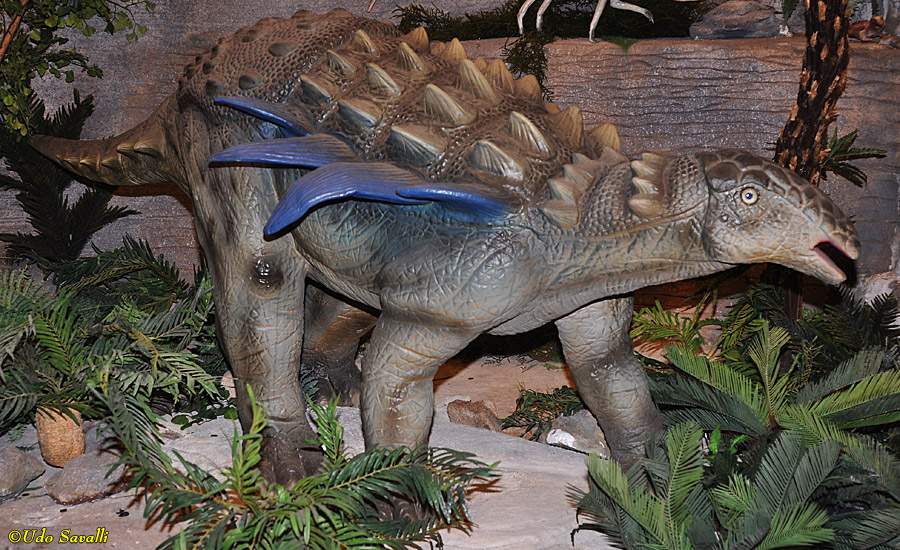
|
|
|
Life model of Liaoningosaurus paradoxus, a small juvenile specimen (adults are unknown). Some features suggest it might have been aquatic, and it had fish in its stomach (unclear of predation or scavenging), but these might just be juvenile characteristics.
Taxonomy: Dinosauria; Ornithischia; Thyreophora; Ankylosauria; Nodosauridae
Early Cretaceous, 130-125 Ma; China
Fernbank Museum of Natural History, Georgia
|
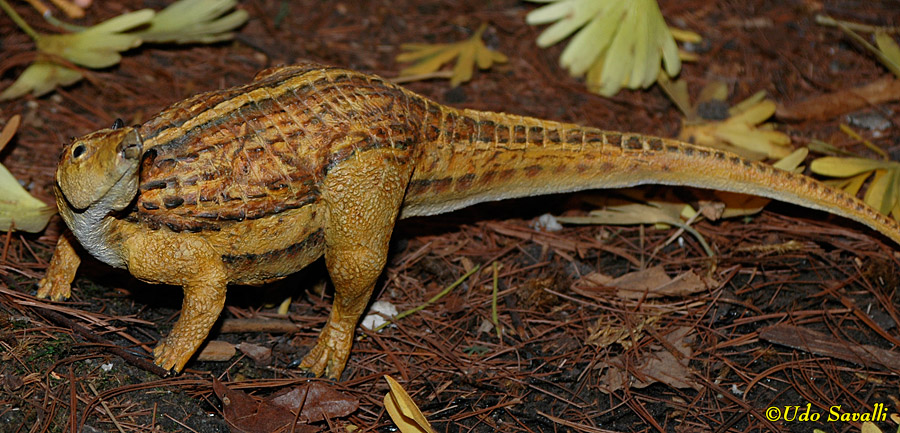
|
|
|
Compared to the nodosaurids, the ankylosaurid family has shorter, broader skulls, as in this Ankylosaurus sp. (compare with above). While they often have spikes or 'horns' on the back of their head, the rest of their body generally does not have the large spikes present in many nodosaurids.
Taxonomy: Ornithischia, Thyreophora, Ankylosauria, Ankylosauridae
Alberta
Late Cretaceous Period
Museum of the Rockies, Montana
|
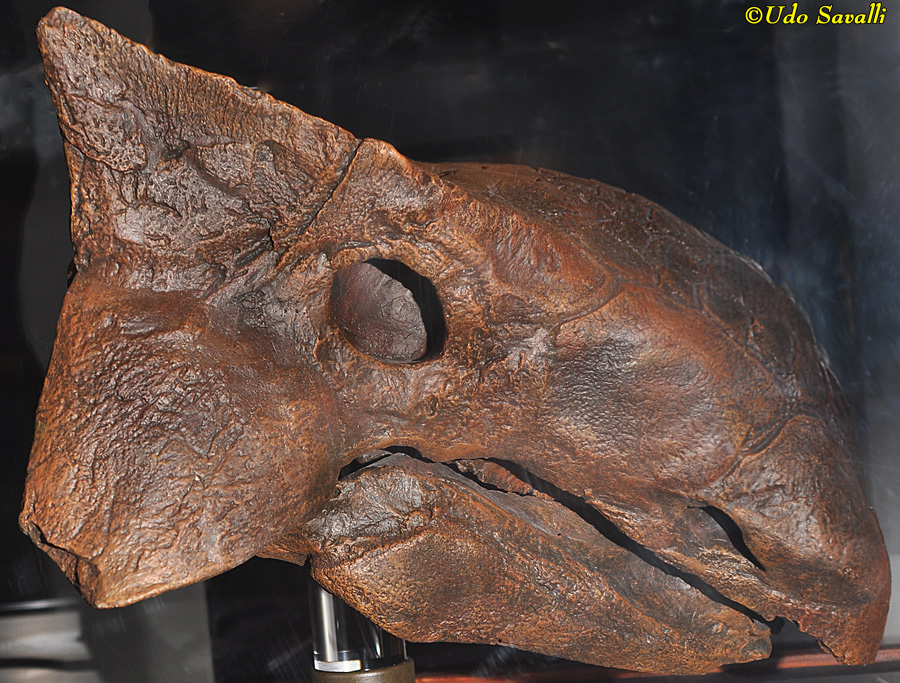
|
|
|
Most ankylosaurids, such as this Ankylosaurus sp., had a bony club at the end ot their tail, presumably used in defense.
Taxonomy: Ornithischia, Thyreophora, Ankylosauria, Ankylosauridae
Garfield Co., Montana
Late Cretaceous Period
Museum of the Rockies, Montana
|
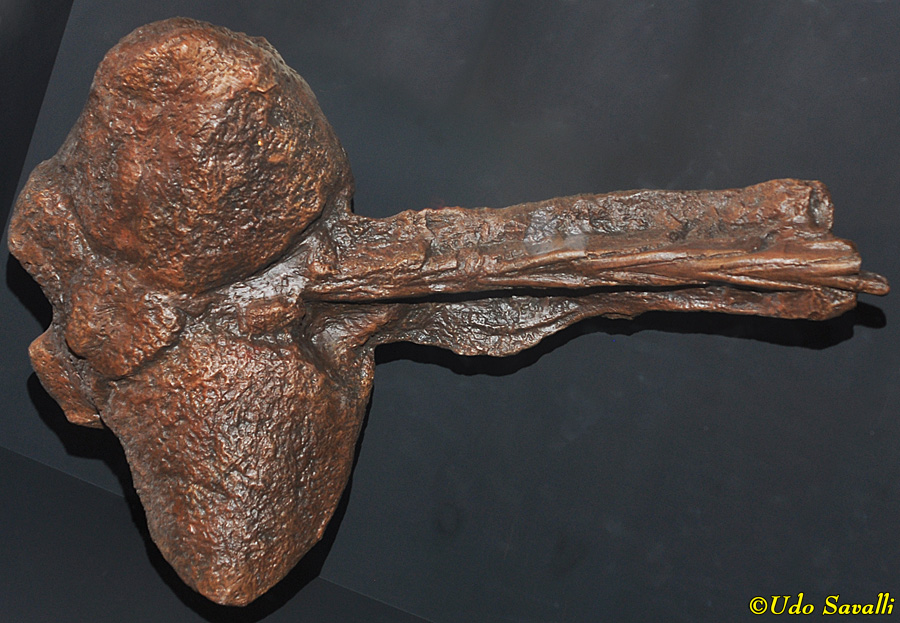
|
|
|
The tail club of another ankylosaurid, Euoplocephalus tutus.
Taxonomy: Ornithischia, Thyreophora, Ankylosauria, Ankylosauridae
Dinosaur Park Formation, Alberta, Canada
late Cretaceous Period, 76 Ma
Denver Museum of Science & Nature
|
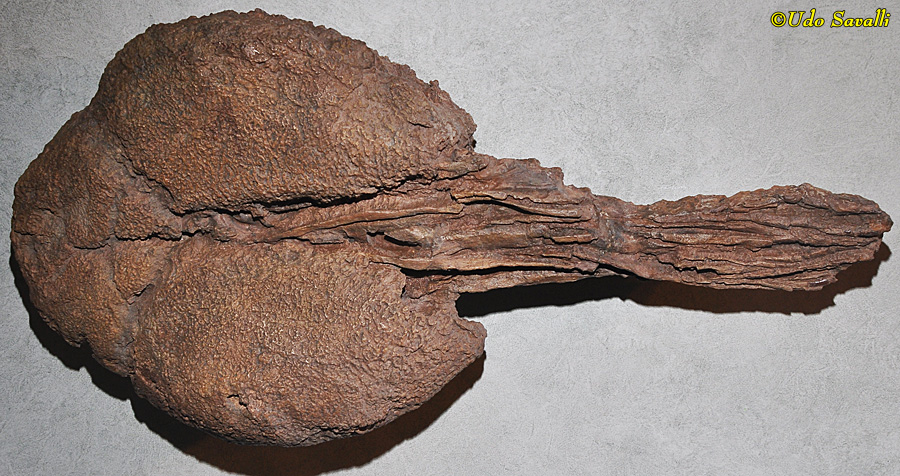
|
|
|
Skull of the ankylosaurid Saichania chulsanensis.
Taxonomy: Ornithischia, Thyreophora, Ankylosauria, Ankylosauridae
Barun Goyot Formation, Omnogov, Mongolia
Late Cretaceous Period, Campanian Stage
Black Hills Institute Museum, South Dakota
|
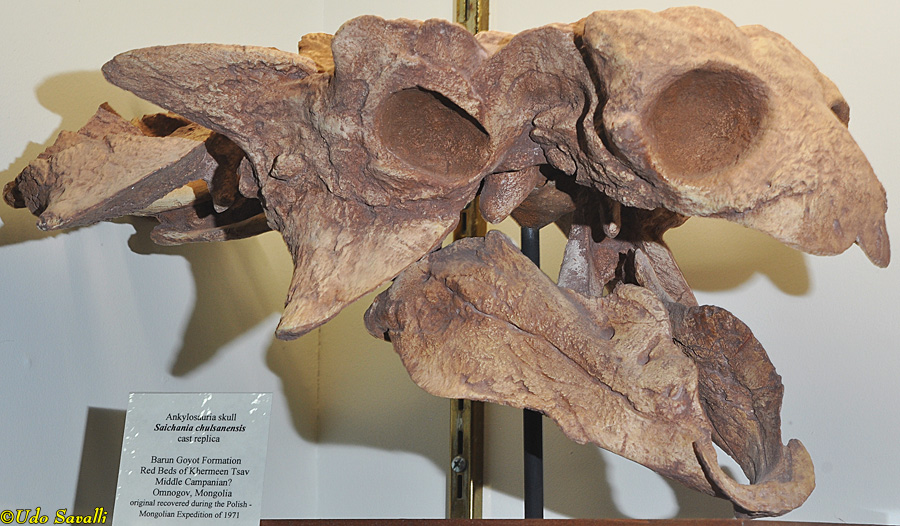
|
|
|
Skull of the ankylosaurid Minotaurasaurus ramachandrani.
Taxonomy: Ornithischia, Thyreophora, Ankylosauria, Ankylosauridae
Barun Goyot Beds, Mongolia
Late Cretaceous Period, Campanian Stage
Black Hills Institute Museum, South Dakota
|
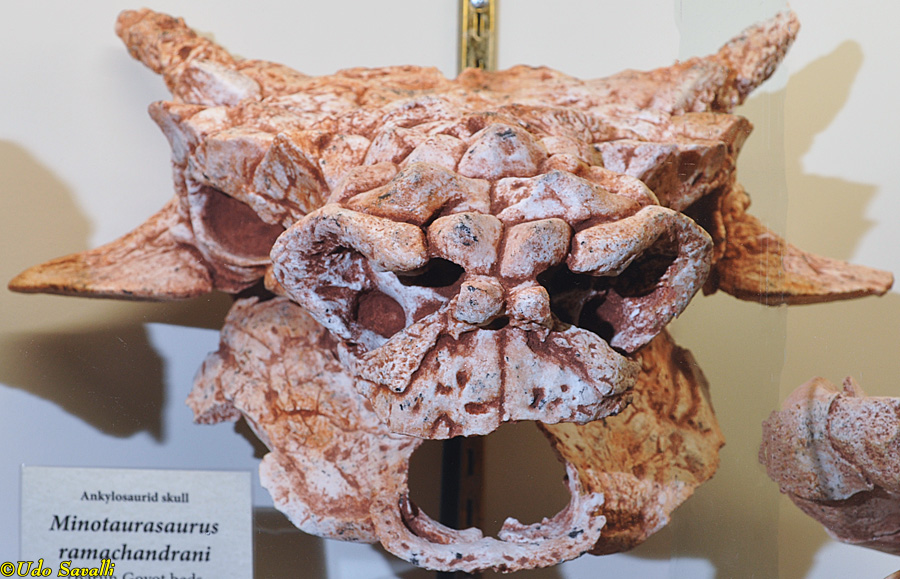
|
|
|
Life model of Talarurus plicatospineus.
Taxonomy: Dinosauria; Ornithischia; Thyreophora; Ankylosauria; Ankylosauridae
Late Cretaceous Period, 99-88 Ma; Mongolia
Fernbank Museum of Natural History, Georgia
|
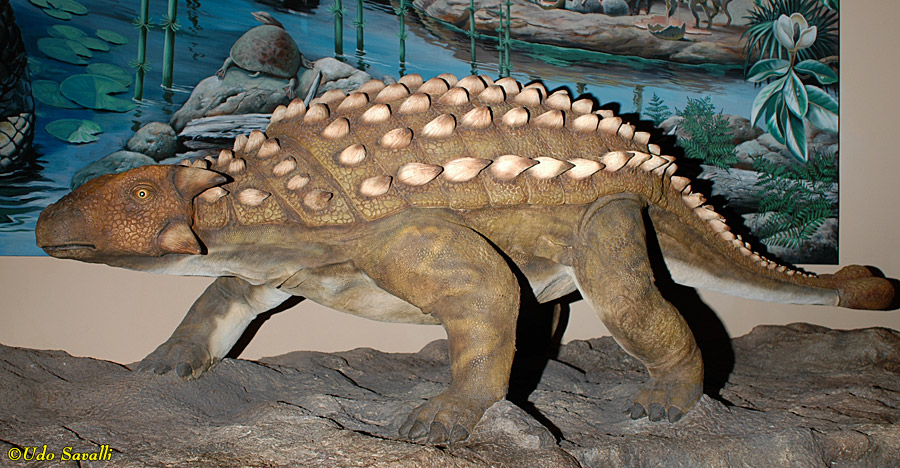
|
|
|
Life model of Aletopelta coombsi.
Taxonomy: Dinosauria; Ornithischia; Thyreophora; Ankylosauria; Ankylosauridae
Cretaceous Period; California
San Diego Natural History Museum
|
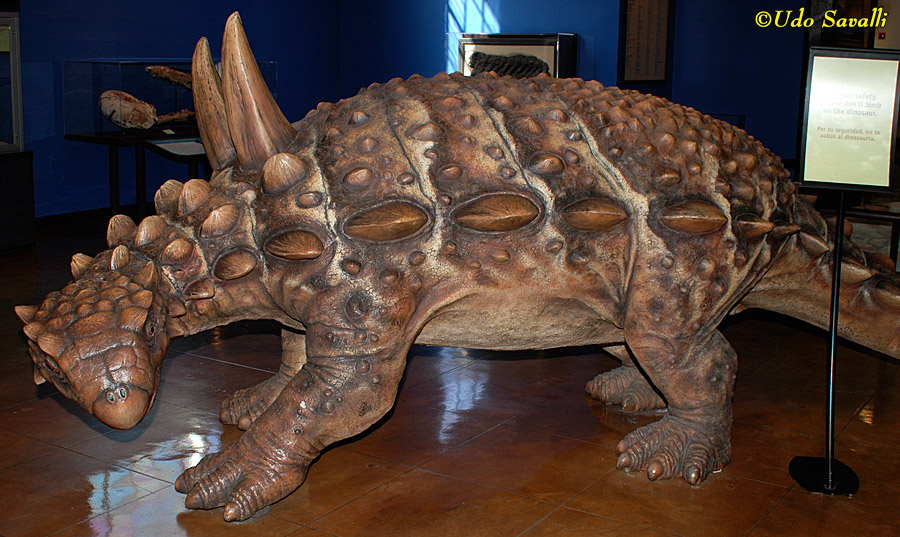
|
|
Stegosauria — Stegosaurs
|
The Stegosauria are characterized by having 2 rows of dorsal osteoderms that protrude to form flat plates or spikes running from the neck to the end of the tail. They have longer hind legs than forelegs and a small skull. At the end of the tail is a set of 4 spikes, called the thagomizer, that likely functioned in defense.
Stegosaurus is the largest sized stegosaur. Unlike in most other stegosaurs, the plates are offset from the ones on the opposite side instead of being paired together.
Taxonomy: Ornithischia, Thyreophora, Stegosauria
Western North America
Late Jurassic Period
New Mexico Museum of Natural History & Science
|
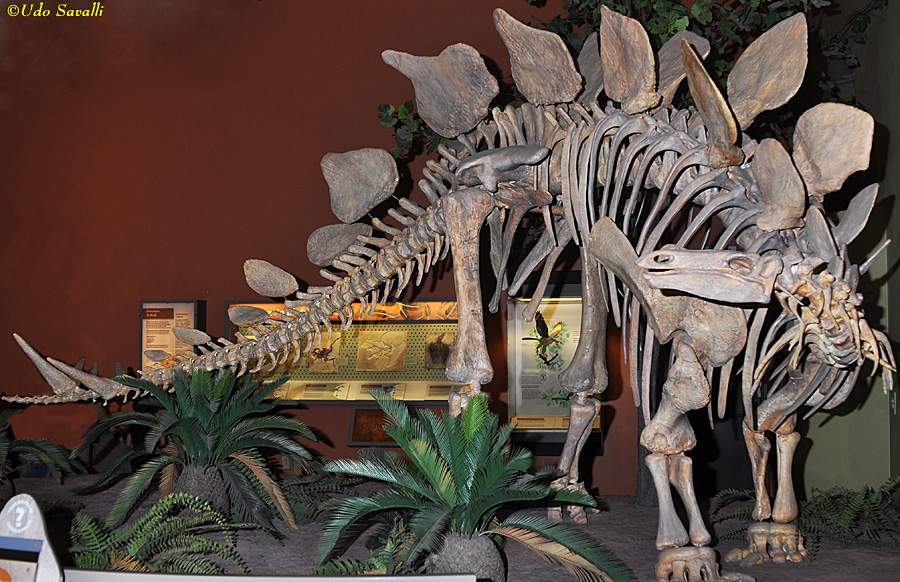
|
|
|
Stegosaurus stenops adult (75% bone) with two juveniles (50% cast from 2 specimens).
Taxonomy: Ornithischia, Thyreophora, Stegosauria
Morrison Formation, Fremont Co., Colorado
Late Jurassic Period
Denver Museum of Science & Nature
|
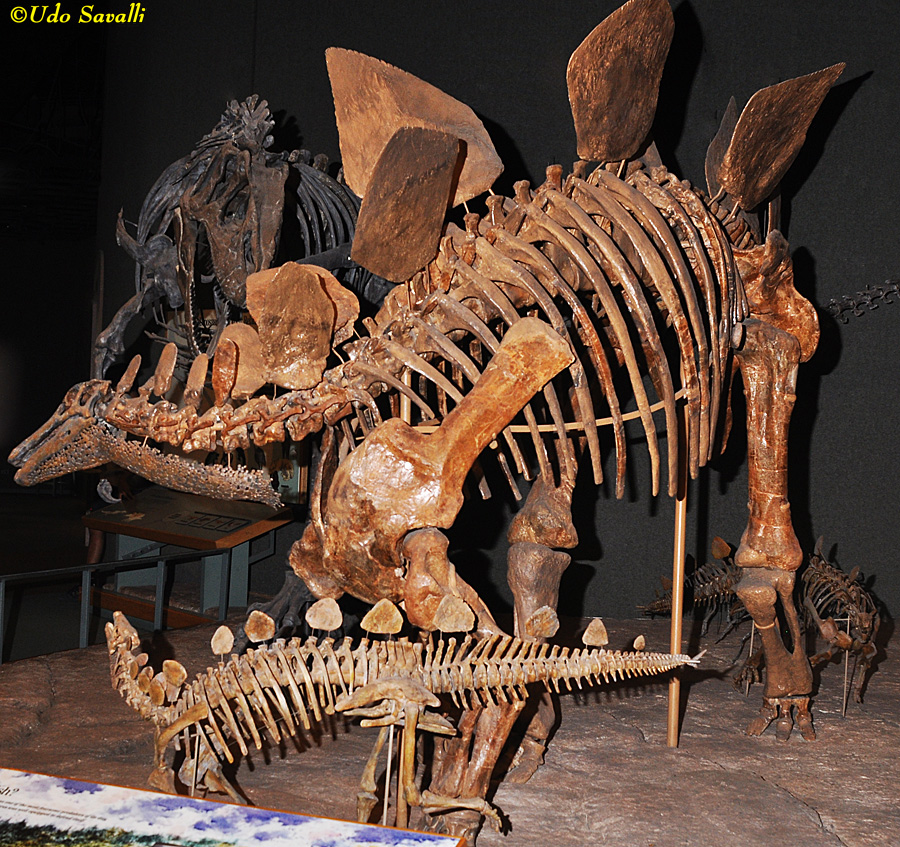
|
|
|
Fossil (real) of a partial Stegosaurus stenops, including skin impression showing the scutes (osteoderms) that cover the throat (lower left).
Taxonomy: Ornithischia, Thyreophora, Stegosauria
Late Jurassic Period
Denver Museum of Science & Nature
|
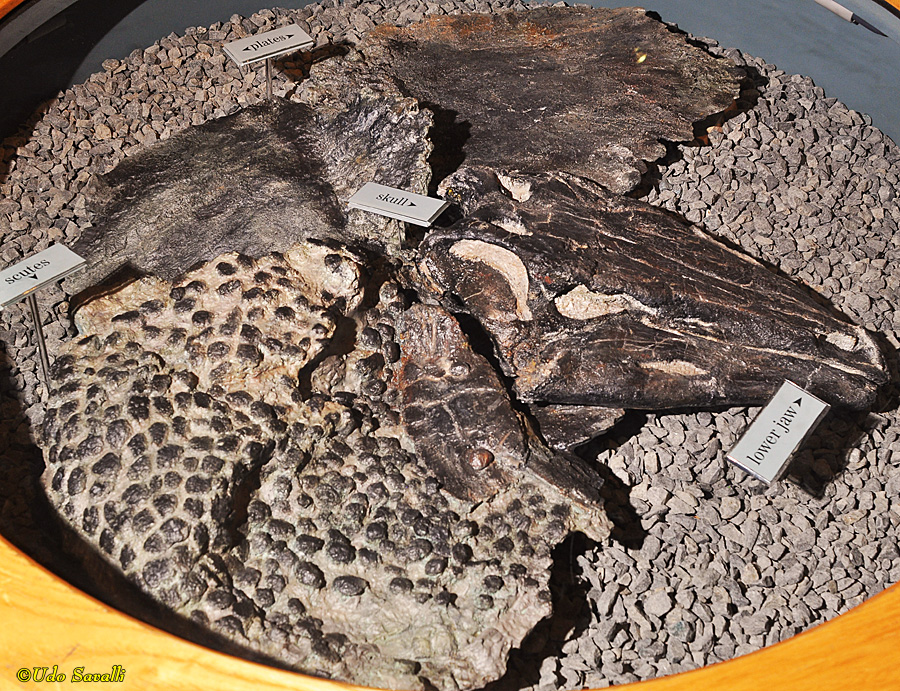
|
|
|
Hesperosaurus mjosi, a close relative of Stegosaurus.
Taxonomy: Ornithischia, Thyreophora, Stegosauria
Late Jurassic Period, Kimmeridgian-Tithonian Stages
Museum of Ancient Life, Utah
|
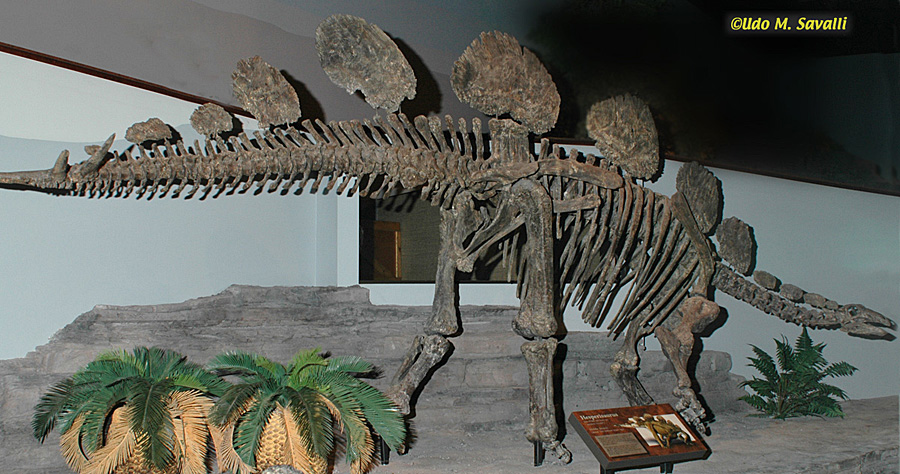
|
|
|
Tuojiangosaurus multispinus (with a Monolophosaurus in the background).
Taxonomy: Ornithischia, Thyreophora, Stegosauria
Upper Shaximiao Formation, China
Late Jurassic Period, 160 Ma
Arizona Science Center (temporary exhibit)
|
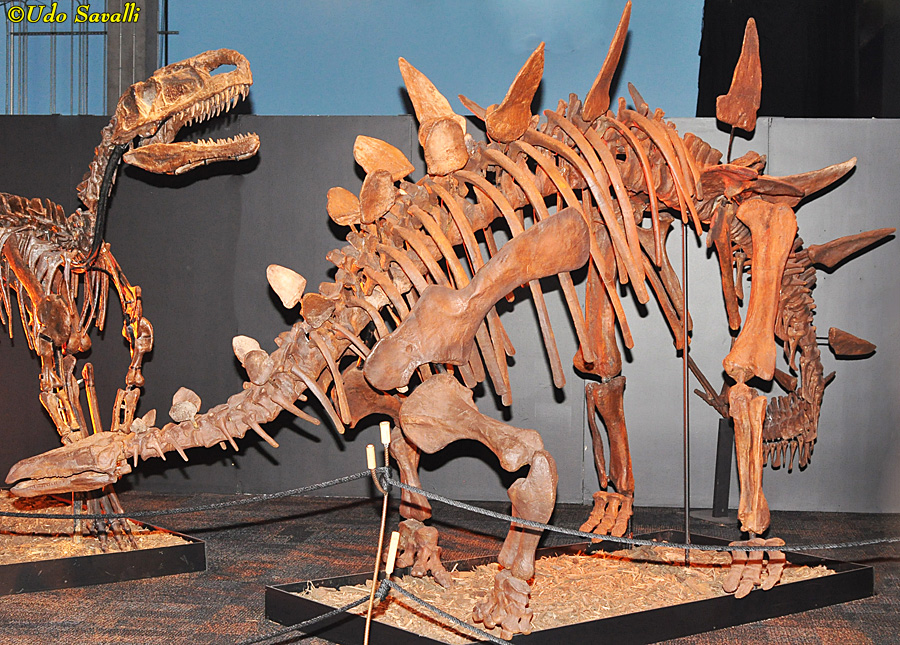
|
|
|





















